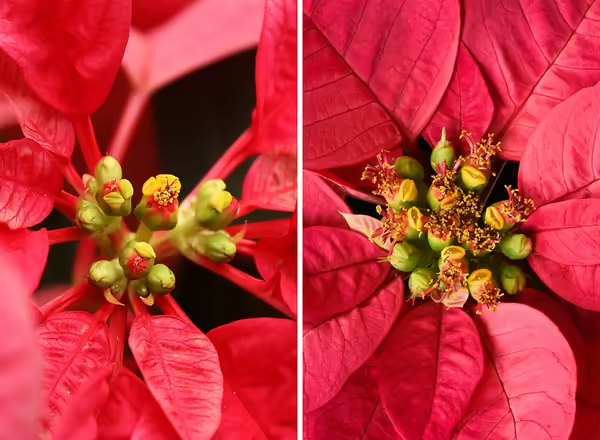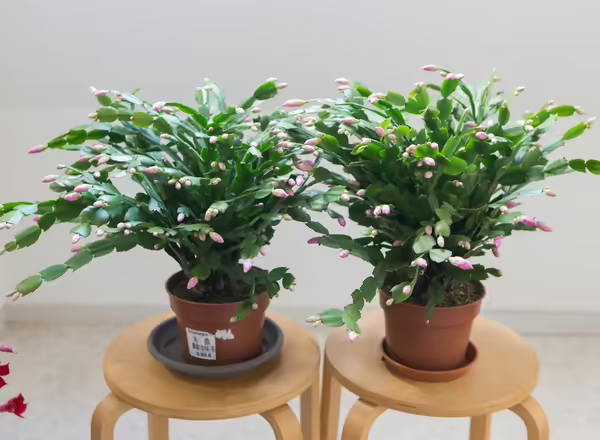
The holiday season is here, which means evergreens, poinsettias, amaryllis, and other holiday plants have arrived in stores. Plants are often at the center of our holiday decorations and traditions and are frequently given as gifts. Whether buying them as gifts or for yourself, following a few tips can help you or the recipient enjoy them throughout the holiday season.
Poinsettia
Poinsettias are the most popular holiday plant in the United States, with around 40 million plants sold yearly. While we grow them as a houseplant, in their native Mexico, they grow as a shrub. What are widely considered the flowers of the plants are actually bracts (leaves) that look like petals. The greenish-yellow flowers (cyathia) are clustered at the center of the bracts.
When selecting poinsettias, pay close attention to the flowers. Look for plants that have flower buds that are closed and contain a green tint. Flowers that are open and producing pollen (often seen as yellow dust on the leaves) should be avoided because poinsettias will drop their bracts and leaves soon after flowers shed their pollen.
While we traditionally think of poinsettias as red, breeders have produced a variety of different colored cultivars. They can now be found in white, pink, orange, red, and golden-yellow. Some can also be striped or speckled with various colors. The blue and purple poinsettias you may have seen are cream-colored cultivars that have been spray painted.


Christmas cactus
While they are commonly referred to as Christmas cacti, several different types of holiday cacti are sold: Thanksgiving, Christmas cactus, and Easter/Spring cactus. They get their common names from the holiday closest to their traditional bloom dates. However, they may be forced to bloom at other times of the year.
Most of the 'Christmas cactuses' sold are actually Thanksgiving cacti that have had their forced to bloom around Christmas time. Regardless of the type of holiday cacti you purchase, if you want them to bloom around Christmas, look for plants with well-developed buds but no open flowers in late November or early December. Plants that are in full bloom around this time will likely be done blooming by Christmas.
Amaryllis
Many of the amaryllis plants available this time of year come pre-potted, and you'll occasionally find some that have already started to grow. All you need to do is give them some light and water. You can also purchase the bulbs and plant them yourself.
Size is important when it comes to selecting amaryllis bulbs. Larger bulbs will be able to produce more flowers. Larger bulbs also tend to produce thicker, stronger stems and are less likely to flop. So, try to purchase the largest bulbs for the best floral display. Inspect bulbs to ensure they are firm and don't have any mold, decay, or signs of injury.
Norfolk Island Pine
Norfolk Island pines are widely marketed as living Christmas trees and are commonly adorned with bells and bows. Despite their name, these evergreens are not actually pine trees (they belong to the Araucariaceae, not Pinaceae). In their native habitat in the South Pacific, they can reach heights of up to 200 feet and have trunks up to 10 feet in diameter.
When selecting a Norfolk Island pine, look for uniformly green plants with few brown or yellow needles. Make sure to pay close attention, though. They are often spray-painted green or covered in glitter, which can interfere with the plant's ability to photosynthesize. So, if you want to keep your plant long-term, avoid painted plants, or be prepared to remove as much paint as possible.
Transporting holiday houseplants
Most of the holiday plants we grow are of tropical origin, and exposure to cold conditions can damage or even kill plants if exposed for too long. Here are a few steps you can take to prevent damage to your newly purchased plants:
- If you are making multiple stops, make purchasing your plants your last stop to avoid leaving plants in a vehicle with no heat.
- If possible, avoid purchasing plants on particularly cold or windy days (easier said than done during the winter, I know) to reduce the chances of them being damaged.
- Insulate your plants the best you can. Call the store beforehand to see if they have material you can use to insulate your plants, like paper. If they don't, you can bring your own.
- After purchasing your plants, wrap them in paper and place them in a bag. Double bagging them if possible and keep the top of the bags closed. Paper bags will insulate plants better than plastic bags.
- Have your vehicle warmed up before you put the plants in; it may be helpful to bring someone with you who can wait in the vehicle or go and warm it up before you leave with your plants.
- Do not put plants in the vehicle's trunk; it will be colder than in the cab. Also, don't let the plant's foliage touch cold windows; this can damage the leaves.
Need information on caring for your holiday plants? Check out these Good Growing articles:
Poinsettia
Holiday cacti
Amaryllis
Norfolk Island Pines
Good Growing Tip of the Week: Regardless of the type of plant you select, inspect them carefully to ensure they appear healthy and free of pests and diseases. It's also a good idea to avoid purchasing plants placed near the entrances of stores that are exposed to cold air and those directly under heaters, which may get too warm or dry the plants out.
Photo Credits
Closed poinsettia flowers: "Poinsettia- close up of the flower" (Public Domain) by Alabama Extension
Open poinsettia flowers: "Poinsettia" (Public Domain) by Mustang Joe
Thanksgiving cacti: "Schlumbergera pink" (CC BY 2.0) by blumenbiene
Sign up for our emails! Want to get notified when new Good Growing posts are available? SIGN ME UP
Give us feedback! How helpful was this information (click one): Very helpful | Somewhat helpful | Not very helpful
MEET THE AUTHOR
Ken Johnson is a Horticulture Educator with University of Illinois Extension, serving Calhoun, Cass, Greene, Morgan, and Scott counties since 2013. Ken provides horticulture programming with an emphasis on fruit and vegetable production, pest management, and beneficial insects. Through his programming, he aims to increase backyard food production and foster a greater appreciation of insects.